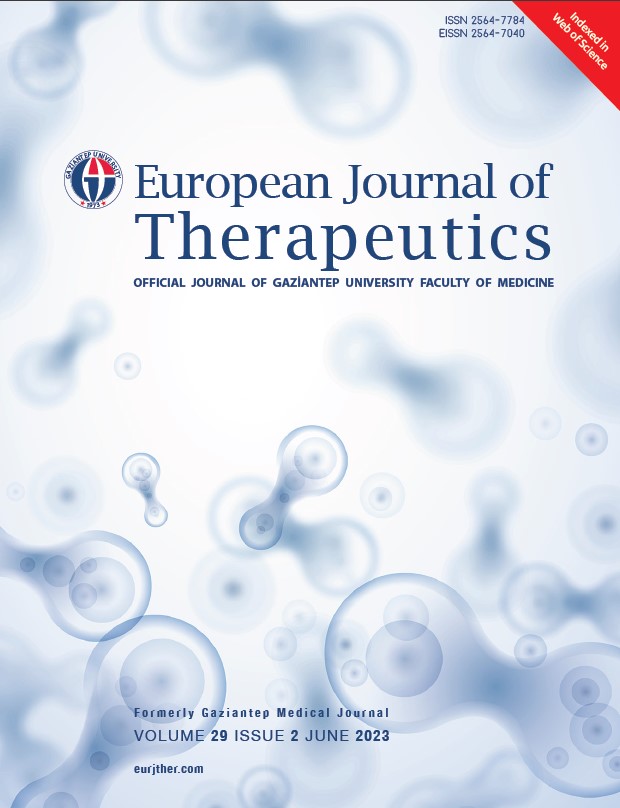Evaluation of the Image Quality of Ultra-Low-Dose Paranasal Sinus Computed Tomography Scans
DOI:
https://doi.org/10.58600/eurjther.20232902-1131.yKeywords:
Multidetector Computed Tomography, paranasal sinus, Radiation exposureAbstract
Objective: We aimed to investigate the image quality of paranasal sinus computed tomography (CT) scans obtained with the “Advanced intelligent Clear-IQ Engine” (AICE) software and ultra-low dose parameters in patients with prediagnosed rhinitis, sinusitis or nasal septum deviation.
Methods: The first 50 patients (31 men and 19 women, aged 18-70 years) who agreed to participate in our prospectively planned study were included in the study. Imaging of the patients was performed with a 160-slice multidetector CT device Canon Aquilion Prime SP (Canon Medical Systems, Otawara, Japan). Tube voltage of 80 kV and tube current of 40 mA were chosen. The effective radiation dose (ED) was calculated based on the “dose-length product” (DLP) information of each patient. Evaluation of images was made on reformat images made with “AiCE Bone” filter in the axial and coronal planes. All images were double-blindly evaluated by 2 radiologists out of 5 points (5 = very good; 1 = not diagnostic). The visibility of 17 bilateral important anatomical landmarks examined on paranasal sinus CT was scored (0 = not visible; 2 = completely visible). In the evaluation of images, the agreement between radiologists was evaluated with Kappa statistics.
Results: The median ED value of the CT protocol was 0.015±0.001 mSv [range 0.012-0.017 mSv]. The overall image quality of the images in our study was interpreted as 4 (good) or 3 (moderate) for all patients. Inter-research agreement was 92%. Most of the anatomical landmarks evaluated were completely visible. Six (bilateral of three) anatomical landmarks could be partially visible in some patients.
Conclusion: Combining the ultra-low dose CT protocol and the AiCE reconstruction algorithm makes it possible to achieve very low ED values in paranasal sinus CT scans and still obtain sufficient image quality in indications such as septum deviation and sinusitis.
Metrics
References
Desouky O, Ding N, Zhou G. (2015) Targeted and non-targeted effects of ionizing radiation. J Radiat Res Appl Sci. 8(2):247-54. https://doi.org/10.1016/j.jrras.2015.03.003
Petritsch B, Kosmala A, Weng AM, Bley TA (2019) Tin-filtered 100 kV ultra-low-dose CT of the paranasal sinus: Initial clinical results. PLoS One. 14(5):e0216295. https://doi.org/10.1371/journal.pone.0216295
O’Brien Sr WT, Hamelin S, Weitzel EK (2016) The preoperative sinus CT: avoiding a “CLOSE” call with surgical complications. Radiology. 281(1):10-21. https://doi.org/10.1148/radiol.2016152230
Diklić A, Zujić PV, Šegota D, Debeljuh DD, Jurković S, Brambilla M, Kalra MK (2020) Optimization of paranasal sinus CT procedure: Ultra-low dose CT as a roadmap for pre-functional endoscopic sinus surgery. Phys Med. 78:195-200. https://doi.org/10.1016/j.ejmp.2020.09.014
Bongartz G. European guidelines on quality criteria for computed tomography: 1999.
Chaparian A, Tavakoli I, Karimi V (2013) Organ doses, effective dose, and radiation risk assessment in radiography of pediatric paranasal sinuses (Waters view). Asian Biomed. 7(5):695-8. https://doi.org/10.5372/1905-7415.0705.228
Bodelle B, Wichmann JL, Klotz N, Lehnert T, Vogl TJ, Luboldt W, Schulz B (2015) Seventy kilovolt ultra-low dose CT of the paranasal sinus: first clinical results. Clin Radiol. 70(7):711-5. https://doi.org/10.1016/j.crad.2015.03.002
Kearney SE, Jones P, Meakin K, Garvey CJ (1997) CT scanning of the paranasal sinuses--the effect of reducing mAs. Br J Radiol. 70(838):1071-4. https://doi.org/10.1259/bjr.70.838.9404216
Brem MH, Zamani AA, Riva R, Zou KH, Rumboldt Z, Hennig FF, Kikinis R, Norbash AM, Schoepf UJ (2007) Multidetector CT of the paranasal sinus: potential for radiation dose reduction. Radiology. 243(3):847-52. https://doi.org/10.1148/radiol.2433050207
Bulla S, Blanke P, Hassepass F, Krauss T, Winterer JT, Breunig C, Langer M, Pache G (2012) Reducing the radiation dose for low-dose CT of the paranasal sinuses using iterative reconstruction: feasibility and image quality. Eur J Radiol. 81(9):2246-50. https://doi.org/10.1016/j.ejrad.2011.05.002
Aksoy EA, Özden SU, Karaarslan E, Ünal ÖF, Tanyeri H (2014) Reliability of high-pitch ultra-low-dose paranasal sinus computed tomography for evaluating paranasal sinus anatomy and sinus disease. J Craniofac Surg. 25(5):1801-4. https://doi.org/10.1097/scs.0000000000000966
Schaafs LA, Lenk J, Hamm B, Niehues SM (2016) Reducing the dose of CT of the paranasal sinuses: potential of an iterative reconstruction algorithm. Dentomaxillofac Radiol. 45(7):20160127. https://doi.org/10.1259/dmfr.20160127
Downloads
Published
How to Cite
License
Copyright (c) 2023 European Journal of Therapeutics

This work is licensed under a Creative Commons Attribution-NonCommercial 4.0 International License.
The content of this journal is licensed under a Creative Commons Attribution-NonCommercial 4.0 International License.


















